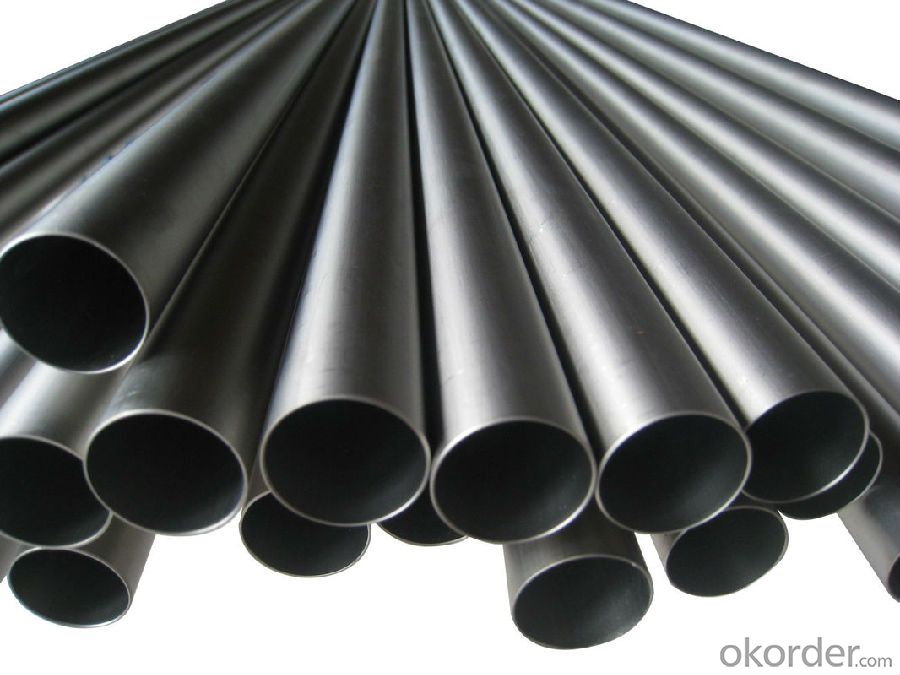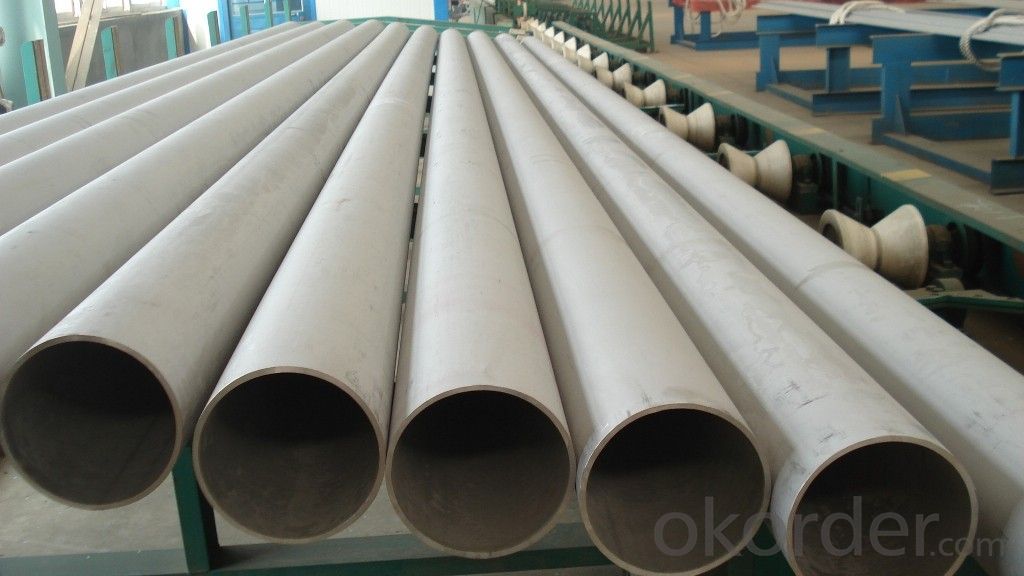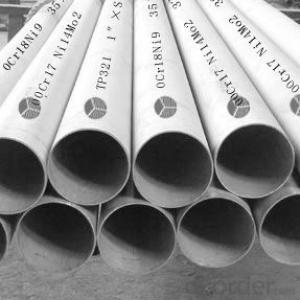Stainless Duplex Seamless Steel Pipe High Nicke 31803
- Loading Port:
- Ningbo
- Payment Terms:
- TT OR LC
- Min Order Qty:
- 1 m.t.
- Supply Capability:
- 5000 m.t./month
OKorder Service Pledge
OKorder Financial Service
You Might Also Like
1、Structure of Duplex steel A790 31803 seamless pipe Description:
Stainless steel is a production which not easy rust,acid resistance and corrosion resistance,so it is widely used in light industry,heavy industry,daily necessities and the decoration industry.my company long-term supply stainless steel porducts including:stainless steel sheet,stainless steel coil and stainless steel tube.
2、Main Features of Duplex steel A790 31803 seamless pipe:
• High manufacturing accuracy
• High strength
• Small inertia resistance
• Strong heat dissipation ability
• Good visual effect
•Reasonable price
3、Duplex steel A790 31803 seamless pipe Images:



4、Duplex steel A790 31803 seamless pipe Specification:
1. Process: Cold Rolling/ Cold Drawn
2. Size: 10mm-480mm
3. Standards: ASTM A312, ASTM A213, ASTM A269, DIN 2462, JIS G3463
4. Schedules:1mm-30mm
5. Material: TP304, TP304L, TP316L, TP321, TP317L, TP310S, TP347H, duplex steel
6.Surface Treatment: polishing, sand blasting,annealing and acid pickling
7.Package: export package (weaving bag ,non-fabric ,wooden case)
| process | size | standard | schecules | material | surface | package |
cold drawn/ cold rolling | 10-480mm | A312 A213 A269 etc. | 1-30mm | 304/321/316 310/317/347 duplex steel
| polishing annealing and pickling
| weaving bag in bundle plywood case |
5、FAQ of Duplex steel A790 31803 seamless pipe:
①How is the quality of your products?
Our products are manufactured strictly according to national and internaional standard, and we take a test
on every pipe before delivered out. If you want see our quality certifications and all kinds of testing report, please just ask us for it.
Guaranteed: If products’ quality don’t accord to discription as we give or the promise before you place order, we promise 100% refund.
②How about price?
Yes, we are factory and be able to give you lowest price below market one, and we have a policy that “ for saving time and absolutely honest business attitude, we quote as lowest as possible for any customer, and discount can be given according to quantity”,if you like bargain and factory price is not low enough as you think, just don’t waste your time.Please trust the quotation we would give you, it is professional one.
③Why should you chose us?
Chose happens because of quality, then price, We can give you both.Additionally, we can also offer professional products inquiry, products knowledge train(for agents), smooth goods delivery, exellent customer solution proposals.Our service formula: good quality+good price+good service=customer’s trust
SGS test is available, customer inspection before shipping is welcome, third party inspection is no problem.
Any question, pls feel free to contact us !
- Q:What is the difference between 304LN and 304 stainless steel pipes?
- The main difference between 304LN and 304 stainless steel pipes lies in their chemical composition and mechanical properties. 304LN stainless steel is a nitrogen-strengthened version of 304 stainless steel. The addition of nitrogen improves its strength and resistance to corrosion, making it suitable for various applications in industries such as food processing, chemical processing, and pharmaceuticals. The nitrogen content in 304LN stainless steel is typically higher than that in standard 304 stainless steel, which enhances its overall performance. On the other hand, 304 stainless steel is a widely used austenitic stainless steel grade known for its excellent corrosion resistance, high-temperature strength, and ease of fabrication. It is commonly used in applications such as kitchen appliances, automotive parts, and architectural components. In terms of mechanical properties, 304LN stainless steel generally exhibits higher tensile and yield strength compared to 304 stainless steel. This makes it more suitable for applications that require increased strength or resistance to deformation. However, it is important to note that the specific mechanical properties may vary depending on the manufacturing process and heat treatment of the stainless steel pipes. In summary, the key difference between 304LN and 304 stainless steel pipes lies in their nitrogen content and resulting mechanical properties. While 304 stainless steel is a versatile and corrosion-resistant grade, 304LN stainless steel offers improved strength and corrosion resistance due to the addition of nitrogen. The choice between the two grades depends on the specific application requirements and the desired combination of properties.
- Q:How do you join stainless steel pipes to other materials?
- Joining stainless steel pipes to other materials can be achieved through several methods, depending on the specific application and requirements. Here are a few common techniques used: 1. Welding: Welding is the most common and effective method for joining stainless steel pipes to other materials. Different types of welding processes such as TIG (Tungsten Inert Gas) welding, MIG (Metal Inert Gas) welding, or stick welding can be used, depending on the material being joined and the desired strength of the joint. Welding provides a strong and durable bond between stainless steel pipes and other materials. 2. Flanges: Flanges are commonly used to join stainless steel pipes to other materials in applications that require easy disassembly or connection to different equipment. Flanges are typically made from materials such as carbon steel, cast iron, or even stainless steel itself. The flanges are bolted together, creating a secure joint that can be easily disconnected when needed. 3. Threaded connections: Stainless steel pipes can also be joined to other materials using threaded connections. This method is often used for smaller diameter pipes or when the pipes need to be easily removed or replaced. The threaded connections can be made using pipe fittings such as couplings, unions, or adapters, which have male and female threads that screw together to form a tight seal. 4. Compression fittings: Compression fittings are another option for joining stainless steel pipes to other materials. These fittings consist of a compression nut, a ferrule, and a body that houses the ferrule. The ferrule is compressed onto the pipe, creating a tight seal when the compression nut is tightened. Compression fittings provide a reliable and leak-free joint between stainless steel pipes and other materials. 5. Mechanical connectors: In some cases, mechanical connectors can be used to join stainless steel pipes to other materials. These connectors typically involve clamping or fastening mechanisms that secure the pipes together without the need for welding or threading. Mechanical connectors can be a suitable option in situations where disassembly and reassembly are required. It is important to consider the specific application, material compatibility, and the required strength and durability of the joint when selecting the appropriate method to join stainless steel pipes to other materials. Consulting with a professional or referring to industry standards and guidelines is recommended to ensure a proper and reliable connection.
- Q:Can stainless steel pipes be used for hydroelectric power plants?
- Yes, stainless steel pipes can be used for hydroelectric power plants. Stainless steel is a popular choice for various industrial applications due to its excellent corrosion resistance properties. In a hydroelectric power plant, water is used to generate electricity by passing through turbines. This water can often be corrosive due to its composition and flow rate. Stainless steel pipes are highly resistant to corrosion, making them an ideal choice for conveying the water in hydroelectric power plants. Additionally, stainless steel pipes offer other benefits such as high strength, durability, and the ability to withstand high pressures and temperatures. These properties are crucial for the efficient and reliable operation of the power plant. Stainless steel pipes also maintain their structural integrity over time, reducing the need for frequent maintenance and replacement. Moreover, stainless steel pipes can handle the internal and external pressures created during the power generation process. They can withstand the high-speed flow of water and resist erosion caused by sediment and debris in the water supply. This ensures the longevity and efficiency of the hydroelectric power plant. In summary, stainless steel pipes are an excellent choice for hydroelectric power plants due to their corrosion resistance, strength, durability, and ability to withstand high pressures and temperatures.
- Q:Can stainless steel pipes be galvanized?
- Indeed, it is possible to galvanize stainless steel pipes. Galvanization refers to the application of a safeguarding zinc coating on steel or iron to thwart the occurrence of rust. Although stainless steel already possesses a high level of resistance to corrosion, galvanization can serve as an extra layer of defense in specific situations. However, it is worth mentioning that galvanizing stainless steel pipes is not as prevalent as galvanizing carbon steel pipes since the innate corrosion resistance of stainless steel is generally satisfactory for most applications. Moreover, the process of galvanizing stainless steel can modify its visual appearance and may not be suitable for certain aesthetic prerequisites.
- Q:How do you connect stainless steel pipes?
- Stainless steel pipes can be connected using various methods such as welding, threading, and compression fittings. Welding is the most common method, where the pipes are joined together by heating and melting the metal at the joint, creating a strong and permanent bond. Threading involves screwing the pipes together using threads on the ends, while compression fittings use a nut and ferrule to compress and seal the pipes together. The choice of connection method depends on the specific application and requirements.
- Q:Can stainless steel pipes be wrapped with fiberglass insulation?
- Yes, stainless steel pipes can be wrapped with fiberglass insulation. Fiberglass insulation is commonly used to insulate various types of pipes, including stainless steel pipes. It helps to reduce heat loss and maintain the temperature of the pipe, making it more energy efficient. Additionally, fiberglass insulation also provides soundproofing and condensation control benefits. When wrapping stainless steel pipes with fiberglass insulation, it is important to ensure that the insulation is properly installed and sealed to prevent any gaps or air leaks. This will optimize the insulation performance and ensure maximum energy savings.
- Q:How can the inner walls of stainless steel tubes be polished?
- 1) (used in polishing the inner surface polishing machine): rod is thrown into the tube to drive the impeller 1000 or homemade abrasive wheel rotating speed, and with the rotation of the polishing pipe itself, while rotating slowly forward throwing rod. Generally speaking, first use the 60#-80# wheel of Chiba or abrasive belt wheel for rough throwing, and then gradually fine throwing with high precision according to the requirement of smoothness. Large size pipe 6, more than the general use of thousands of impeller, small size of the pipe can be made with homemade abrasive belt wheel, you can reduce costs.
- Q:What are the different grades of stainless steel used in pipes?
- There are several different grades of stainless steel that are commonly used in pipes, each with its own unique properties and characteristics. The most commonly used grades include: 1. Stainless Steel Grade 304: This is one of the most versatile and widely used grades of stainless steel. It is non-magnetic, has excellent corrosion resistance, and is easily weldable. Grade 304 is commonly used in applications where hygiene and cleanliness are important, such as in food processing plants, hospitals, and pharmaceutical industries. 2. Stainless Steel Grade 316: This grade is known for its superior corrosion resistance, especially in environments with high chloride content or exposure to saltwater. Grade 316 is often used in marine applications, chemical processing plants, and coastal areas where corrosion resistance is crucial. 3. Stainless Steel Grade 321: Grade 321 is stabilized with titanium, making it more resistant to sensitization and intergranular corrosion at elevated temperatures. It is commonly used in high-temperature applications, such as exhaust systems, furnaces, and heat exchangers. 4. Stainless Steel Grade 409: This grade is specifically designed for high-temperature applications, such as automotive exhaust systems. It has excellent heat resistance and low thermal expansion properties, making it ideal for withstanding extreme temperatures. 5. Stainless Steel Grade 904L: Grade 904L has high corrosion resistance and is particularly resistant to pitting and crevice corrosion. It is commonly used in aggressive environments, such as chemical processing plants, offshore oil and gas platforms, and pulp and paper industries. These are just a few examples of the different grades of stainless steel used in pipes. The choice of grade depends on the specific application and the desired properties, such as corrosion resistance, temperature resistance, and mechanical strength.
- Q:What is the difference between hot rolled and cold drawn stainless steel pipes?
- Hot rolled stainless steel pipes are made by heating a steel billet to a high temperature and then rolling it into the desired shape. This process creates a rougher surface and larger dimensions compared to cold drawn stainless steel pipes. On the other hand, cold drawn stainless steel pipes are made by pulling a stainless steel bar through a die at room temperature, resulting in a smoother surface finish and tighter tolerances. Overall, the main difference lies in the manufacturing process and the resulting surface finish and dimensional accuracy of the pipes.
- Q:Are stainless steel pipes resistant to hydrogen embrittlement?
- Yes, stainless steel pipes are generally resistant to hydrogen embrittlement. Hydrogen embrittlement is a phenomenon where hydrogen can penetrate into the structure of certain metals, causing them to become brittle and susceptible to cracking or failure. Stainless steel, however, has a high resistance to hydrogen embrittlement due to its unique composition. Stainless steel is primarily composed of iron, chromium, and other alloying elements such as nickel and molybdenum. The presence of chromium in stainless steel forms a passive oxide layer on the surface, which provides excellent corrosion resistance and acts as a barrier to prevent hydrogen from diffusing into the metal. Additionally, stainless steel pipes are often manufactured using specific grades (e.g., austenitic or duplex stainless steels) that exhibit even higher resistance to hydrogen embrittlement. These grades have a higher content of alloying elements, which further enhances their resistance to hydrogen attack. However, it is important to note that under certain conditions, such as high temperatures and high-pressure environments, stainless steel can still be susceptible to hydrogen embrittlement. Therefore, it is crucial to consider the specific application and operating conditions when selecting stainless steel pipes to ensure their resistance to hydrogen embrittlement.
1. Manufacturer Overview |
|
|---|---|
| Location | |
| Year Established | |
| Annual Output Value | |
| Main Markets | |
| Company Certifications | |
2. Manufacturer Certificates |
|
|---|---|
| a) Certification Name | |
| Range | |
| Reference | |
| Validity Period | |
3. Manufacturer Capability |
|
|---|---|
| a)Trade Capacity | |
| Nearest Port | |
| Export Percentage | |
| No.of Employees in Trade Department | |
| Language Spoken: | |
| b)Factory Information | |
| Factory Size: | |
| No. of Production Lines | |
| Contract Manufacturing | |
| Product Price Range | |
Send your message to us
Stainless Duplex Seamless Steel Pipe High Nicke 31803
- Loading Port:
- Ningbo
- Payment Terms:
- TT OR LC
- Min Order Qty:
- 1 m.t.
- Supply Capability:
- 5000 m.t./month
OKorder Service Pledge
OKorder Financial Service
Similar products
New products
Hot products
Related keywords





























